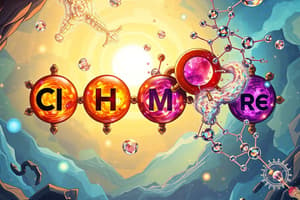Podcast
Questions and Answers
अविषेशीय रसायन विज्ञान के किस क्षेत्र पर ध्यान केंद्रित होगा इस लेख में?
अविषेशीय रसायन विज्ञान के किस क्षेत्र पर ध्यान केंद्रित होगा इस लेख में?
भारी तत्वों और उनके उपयोग
भारी तत्वों के बारे में इस लेख में किस बात का वर्णन किया गया है?
भारी तत्वों के बारे में इस लेख में किस बात का वर्णन किया गया है?
उनके अद्वितीय गुण और उपयोग
सुपरहैवी तत्वों की अविषेशीय संरचनाओं के किस क्षेत्र में उनका प्रयोग हो सकता है?
सुपरहैवी तत्वों की अविषेशीय संरचनाओं के किस क्षेत्र में उनका प्रयोग हो सकता है?
एयरोस्पेस और हेल्थकेयर
अविषेशीय रसायन विज्ञान का किस विषय पर प्रमुख ध्यान दिया गया है इस लेख में?
अविषेशीय रसायन विज्ञान का किस विषय पर प्रमुख ध्यान दिया गया है इस लेख में?
कौटिक रसायनिक रसायनिक रसायन विज्ञान की क्या भूमिका है?
कौटिक रसायनिक रसायनिक रसायन विज्ञान की क्या भूमिका है?
इस क्षेत्र में अनुसंधान जारी रहे हैं, इससे हमें क्या उम्मीद करनी चाहिए?
इस क्षेत्र में अनुसंधान जारी रहे हैं, इससे हमें क्या उम्मीद करनी चाहिए?
क्या होंगे इस क्षेत्र में और भी रोमांचक उन्नतियां और खोज?
क्या होंगे इस क्षेत्र में और भी रोमांचक उन्नतियां और खोज?
कौटिक रसायनिक रसायनिक रसायन की अनुसंधान में क्या भूमिका निभाता है?
कौटिक रसायनिक रसायनिक रसायन की अनुसंधान में क्या भूमिका निभाता है?
कौन-कौन सी क्षेत्रों में अपरकीय रासायनिक योगशास्त्र का प्रयोग होता है?
कौन-कौन सी क्षेत्रों में अपरकीय रासायनिक योगशास्त्र का प्रयोग होता है?
किस अपरकीय योगशास्त्रीय सामग्री ने फेरोसीन में तात्विक रासायनिक विज्ञान को क्रांति लाई?
किस अपरकीय योगशास्त्रीय सामग्री ने फेरोसीन में तात्विक रासायनिक विज्ञान को क्रांति लाई?
किस यौगिक का पहला एक्स-रे संरचना रेडियम यौगिक के आंतर-परस्पर क्रियाशीलता के बारे में जानकारी प्रदान करता है?
किस यौगिक का पहला एक्स-रे संरचना रेडियम यौगिक के आंतर-परस्पर क्रियाशीलता के बारे में जानकारी प्रदान करता है?
कौन-कौन से हाल ही में किए गए प्रगतिशीलता से जुड़े हैं, जिनमें अपरकीय सामग्री का उपयोग किया गया है?
कौन-कौन से हाल ही में किए गए प्रगतिशीलता से जुड़े हैं, जिनमें अपरकीय सामग्री का उपयोग किया गया है?
कौन-कौन से क्षेत्रों में तात्विक रासायनिक योगशास्त्र का महत्व है?
कौन-कौन से क्षेत्रों में तात्विक रासायनिक योगशास्त्र का महत्व है?
कौन-कौन से प्रयोगों की रासायनिक प्रक्रिया को समझने और नए कैटलिस्ट विकसित करने में तात्विक रासायनिक योगशास्त्र की महत्वपूर्ण भूमिका है?
कौन-कौन से प्रयोगों की रासायनिक प्रक्रिया को समझने और नए कैटलिस्ट विकसित करने में तात्विक रासायनिक योगशास्त्र की महत्वपूर्ण भूमिका है?
Flashcards are hidden until you start studying
Study Notes
Inorganic Chemistry: A Comprehensive Overview
Inorganic chemistry is a fundamental field of study that deals with the chemistry of inorganic compounds, excluding organic compounds. It encompasses various subtopics, including catalysis, materials, energy conversion and storage, electronics, and more. This article will focus on several key aspects of inorganic chemistry, particularly in the area of heavy elements and their applications.
Heavy Elements
Heavy elements are those with high atomic numbers, ranging from 80 to 118 in the periodic table. These elements have unique properties and applications, making them an area of significant interest in inorganic chemistry. Some notable examples of heavy elements include:
-
Superheavy Elements: Researchers have discovered more than 2 million inorganic structures of superheavy elements, which have potential applications in various fields, including aerospace and healthcare.
-
Ferrocene: This sandwiched compound revolutionized organometallic chemistry and has been the subject of intense research for decades.
-
Radium: The first x-ray structure of a radium compound has provided insights into the coordination chemistry of this heavy element.
Inorganic Materials
Inorganic materials have a wide range of applications, from catalysis to electronics. Some recent advancements in the field of inorganic materials include:
-
Robotic Chemistry Lab: A robotic chemistry lab has been developed to predict and create new inorganic materials, paving the way for the discovery of new compounds and their potential applications.
-
Metal-Organic Frameworks: These innovative materials have been used to encourage specific chemical reactions, such as the oxidation of iron in ferrocene.
Catalysis and Reaction Mechanisms
Catalysis is a crucial process in many industrial and scientific applications, and inorganic chemistry plays a significant role in understanding and developing new catalysts. Some recent research in this area includes:
-
Catalytic Ammonia Production: Researchers have studied the surface of iron and ruthenium catalysts during ammonia production, providing valuable insights into the catalytic process.
-
Reaction Mechanism for Catalytic Ammonia Production: The reaction mechanism for catalytic ammonia production has been experimentally determined, shedding light on the underlying processes.
Conclusion
Inorganic chemistry is a diverse and rapidly evolving field with numerous applications in various industries. From the study of heavy elements to the development of new materials and catalysts, inorganic chemistry continues to play a crucial role in advancing our understanding of the chemical world and driving innovation in technology. As research in this area continues, we can expect to see even more exciting advancements and discoveries in the years to come.
Studying That Suits You
Use AI to generate personalized quizzes and flashcards to suit your learning preferences.




